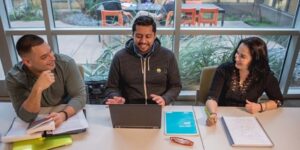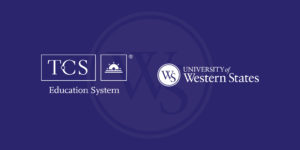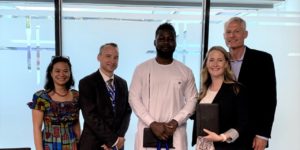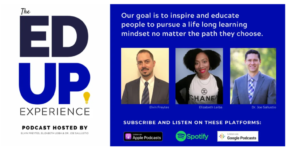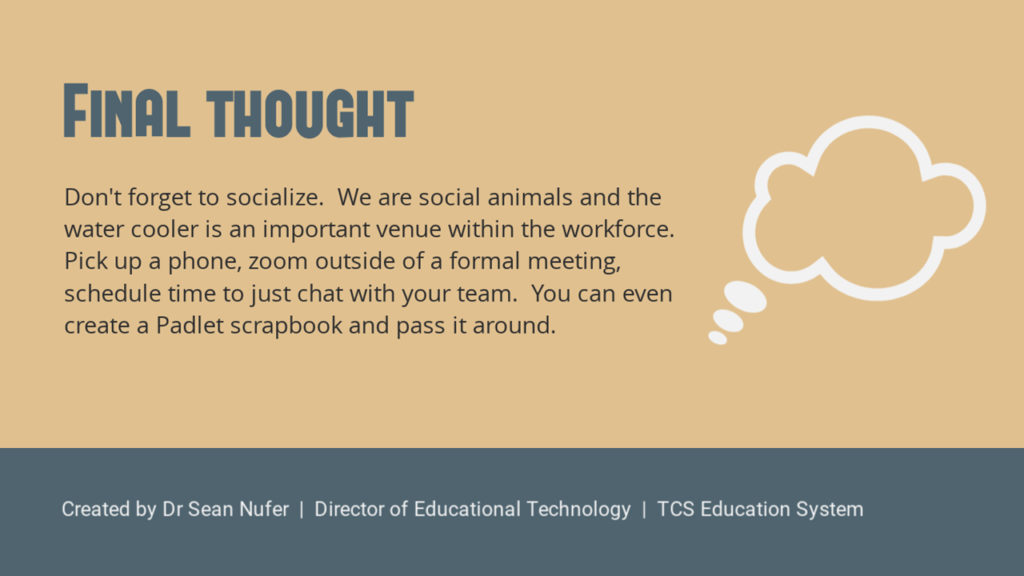The diverse experiences and expertise of the professionals within The Community Solution Education System are foundational to our success. We are a community of professionals with diverse areas of expertise, each bringing unique perspectives and skills to the table. Together, we are shaping a brighter educational future, one that empowers students to make a positive impact on the world.
Our community encompasses a wide range of professional paths, each playing a vital role in achieving our collective goals. From academic experts who ignite a passion for learning to dedicated administrators who provide functional support to our institutions, we are a collective force driving innovation and excellence in education.
Within our organization, we have a range of careers in higher education including human resources careers, financial aid careers, and careers in university administration. Here are just a few examples of the professional journeys that unfold within The Community Solution:
Sean Nufer
Academic Affairs, Senior Director of Teaching and Learning
I lead a team of three exceptional individuals, and our collective role revolves around supporting faculty members across our six institutions to enhance their classroom experiences. We delve into researching effective teaching practices and providing instructors with a range of strategies and resources. The Teaching and Learning Center serves as a cornerstone in our commitment to empowering educators, providing them with a faculty toolkit that aids professors as they plan and develop their courses, advance their teaching practices, incorporate technology, and master the craft of effective and impactful teaching.
The fast-changing environment of higher education brings forth new opportunities and challenges, which we tackle daily guided by fresh data insights. By combining our research data with the best practices and latest findings in pedagogy science, we’re able to help meet the needs and expectations of our students and shape the educational practices and experiences within our classrooms.
At the heart of our efforts lies a crucial mission: to equip faculty to aid students as they tackle real-world challenges and to ensure that their education seamlessly aligns with the diverse demands of various industries. I am firmly committed to equipping students with the essential skills, knowledge, and capabilities that will pave their path to success.
Our model focuses on educational professional development, ensuring that our faculty and staff are equipped with the latest skills and knowledge to excel in their roles.
Financial Aid
Veronica Moran, Director of Financial Aid
As the Director of Financial Aid, I want to highlight that our focus is, without a doubt, the well-being of our students. I’m dedicated to ensuring that financial barriers don’t have to stand in the way of their academic ambitions.
Our overarching objective is to break down the barriers to education and make it a life-changing opportunity. I believe in the power of education to transform lives. Across the System, we function as a united team, working together seamlessly to provide the right support and guidance for students throughout their educational journey. It’s not just about paperwork; it’s about being a driving force behind students’ dreams and aspirations.
Explore open positions in financial aid that are available in various locations, offering crucial support to our student body.
Global Engagement
Ludmi Herath, Director of Global Engagement
In my role as Director of Global Engagement, my focus is to support the internationalization of The Community Solution’s system of colleges and universities by advancing international operations. I lead a team responsible for facilitating international student recruitment and admissions, study abroad programs, faculty exchanges, and immigration compliance across our System.
From conceptualizing initiatives like International Education Week and Global Distinction programs, to educating our communities about the value of global experiences, we take the lead. These endeavors play a pivotal role in expanding our organization’s global influence, fostering profound cross-cultural understanding, and enhancing the educational journeys of everyone involved, most notably our students.
By improving global access for students, faculty, and staff, our department aspires to cultivate meaningful connections and transformative, thought-provoking experiences. Embracing our mission, Global Engagement assists in preparing innovative, engaged, purposeful agents of change who serve our global community.
Human Resources
Olivia Chumbler, Human Resources Generalist
The Human Resources Department is central to our organization’s functionality, and as an HR Generalist, I am at the heart of it all. It’s not just about traditional HR tasks here; our department has the broader mission of serving our community by providing the latest best practices and processes in human resource operations to ensure the well-being of our employees.
My role encompasses a wide spectrum, from managing hiring and onboarding to facilitating training and beyond. My true passion lies in elevating employee wellness and enriching our community with valuable resources. What truly excites me is the opportunity to connect with various departments and deeply understand their daily operations and responsibilities.
In human resources, we prioritize employee wellness and create a nurturing environment. Explore career opportunities in human resources today!
Information Technology
Gordon Snook, IT Help Desk Manager
I hold a supportive position within our IT Department as an IT Help Desk Manager. In this position, I oversee daily operations for a technical support team serving students, faculty, and staff across the country, ensuring service level goals are met and promoting technology adoption. This role involves hands-on incident resolution while managing team performance, customer satisfaction, and adherence to policies. Additionally, I recruit and train staff, maintain technology support systems, and contribute to reducing support requests through communication and training initiatives. I always emphasize that our ultimate objective in the IT Department is to deliver top-tier assistance to our valued community members, all while keeping user satisfaction at the forefront.
As students navigate the journey from prospective student to graduate, I strive for a seamless and consistent digital experience felt throughout their time with us. I believe in embracing the realities of a new, diverse digital workforce with more flexibility, blending work and home life, and exploring new training methods.
Marketing
Cecilia Budzynski, Campaign Manager
In my role as Marketing Campaign Manager, I work collaboratively with team members to build strategies, develop media plans with agency partners, and manage the execution and measurement of those plans. While overseeing our inquiry generation and all paid media placements, I work to present a cohesive narrative that deeply resonates with our entire community. It is my responsibility to ensure smooth communication and foster connections across teams, which is vital in shaping our organization’s image.
Personally, I find immense satisfaction in interacting with others; it’s in these interactions that the true magic unfolds. I firmly believe that no individual can be an expert in every domain. Thus, I emphasize the importance of effective communication with diverse teams and individuals. This communication isn’t just essential for the success of our colleges and universities; it’s critical for the success of the entire System.
If you’re passionate about making a difference through innovative marketing, explore available marketing positions and join us in our mission to shape the future of education.
To learn more about working at The Community Solution and see job openings, visit our careers page.

